Page 408 of 490
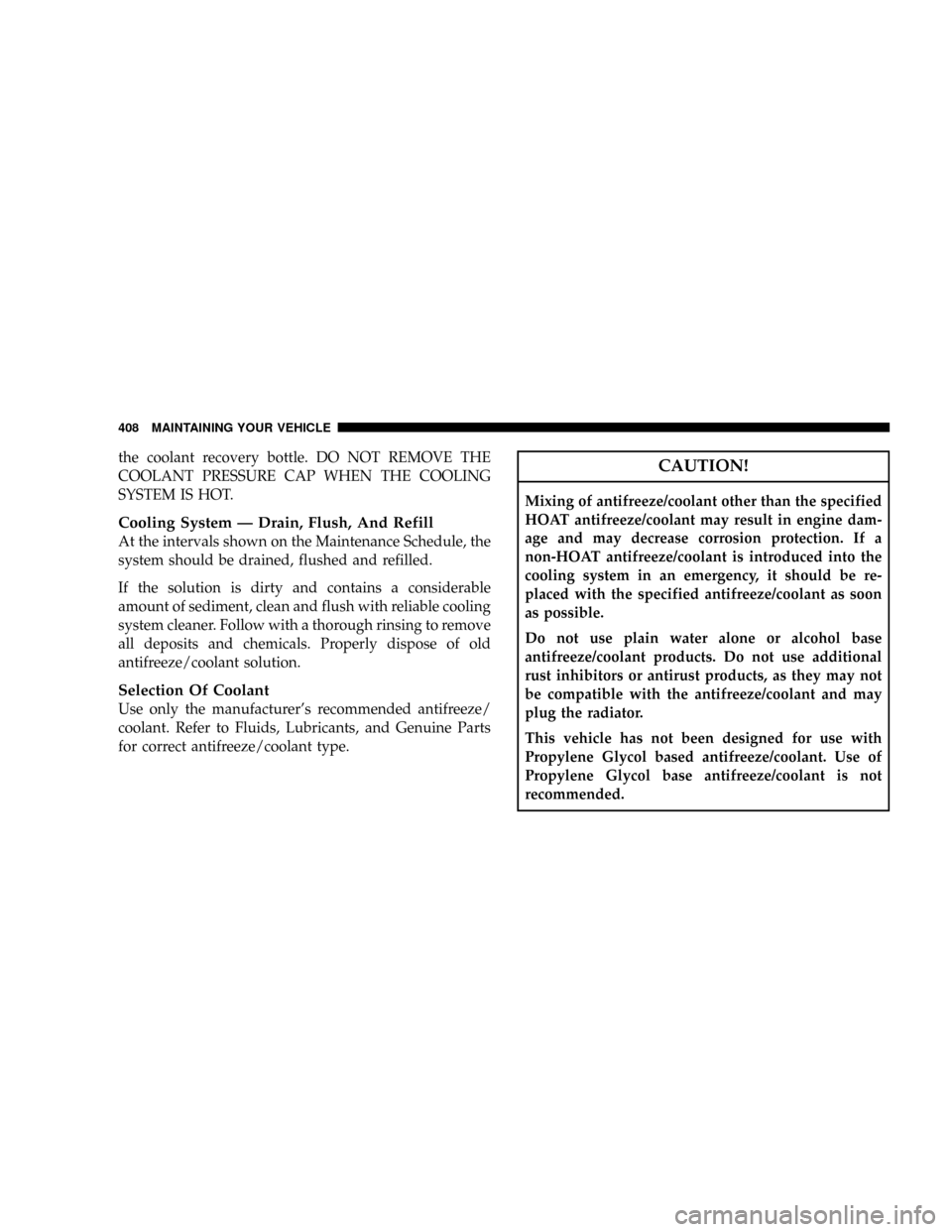
the coolant recovery bottle. DO NOT REMOVE THE
COOLANT PRESSURE CAP WHEN THE COOLING
SYSTEM IS HOT.
Cooling System Ð Drain, Flush, And Refill
At the intervals shown on the Maintenance Schedule, the
system should be drained, flushed and refilled.
If the solution is dirty and contains a considerable
amount of sediment, clean and flush with reliable cooling
system cleaner. Follow with a thorough rinsing to remove
all deposits and chemicals. Properly dispose of old
antifreeze/coolant solution.
Selection Of Coolant
Use only the manufacturer's recommended antifreeze/
coolant. Refer to Fluids, Lubricants, and Genuine Parts
for correct antifreeze/coolant type.
CAUTION!
Mixing of antifreeze/coolant other than the specified
HOAT antifreeze/coolant may result in engine dam-
age and may decrease corrosion protection. If a
non-HOAT antifreeze/coolant is introduced into the
cooling system in an emergency, it should be re-
placed with the specified antifreeze/coolant as soon
as possible.
Do not use plain water alone or alcohol base
antifreeze/coolant products. Do not use additional
rust inhibitors or antirust products, as they may not
be compatible with the antifreeze/coolant and may
plug the radiator.
This vehicle has not been designed for use with
Propylene Glycol based antifreeze/coolant. Use of
Propylene Glycol base antifreeze/coolant is not
recommended.
408 MAINTAINING YOUR VEHICLE
Page 409 of 490
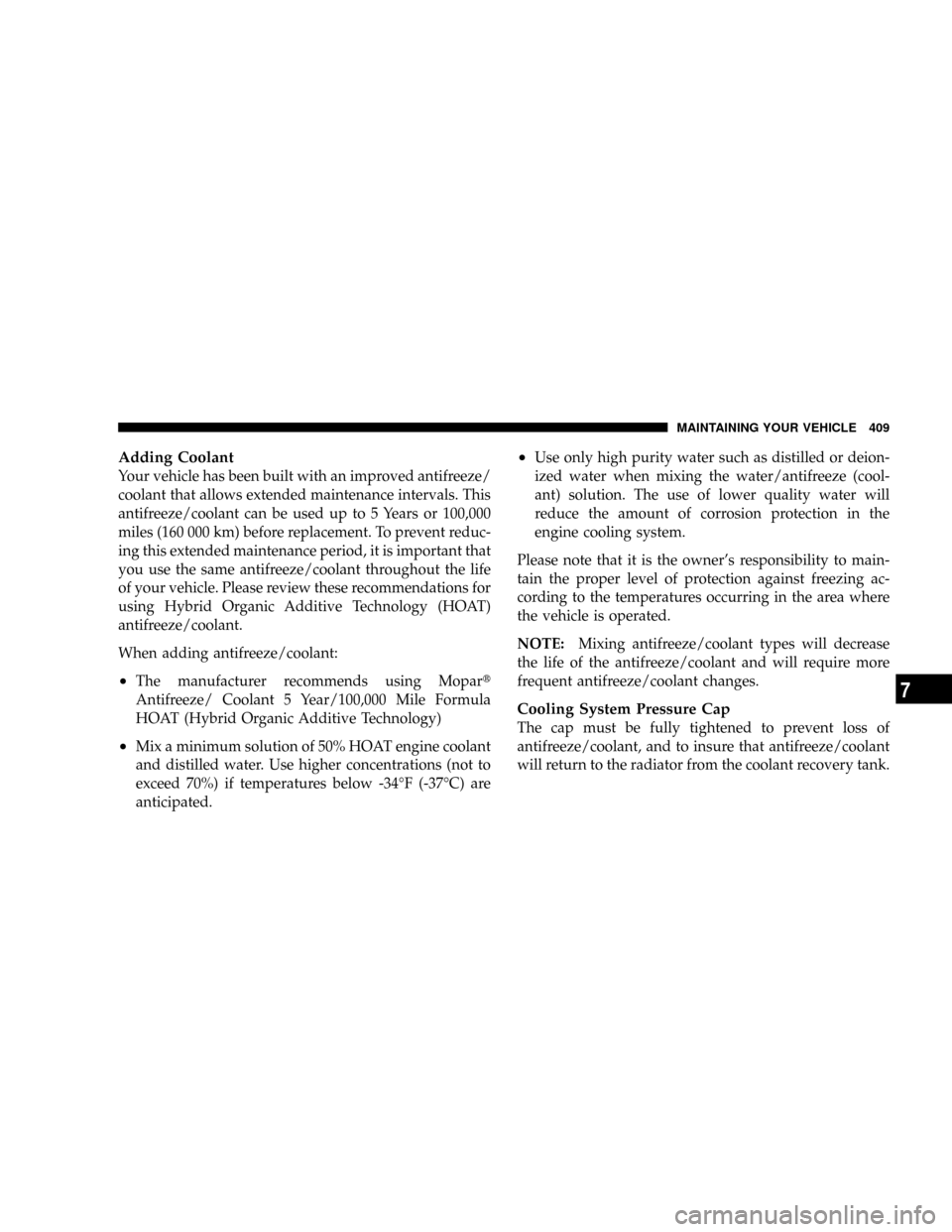
Adding Coolant
Your vehicle has been built with an improved antifreeze/
coolant that allows extended maintenance intervals. This
antifreeze/coolant can be used up to 5 Years or 100,000
miles (160 000 km) before replacement. To prevent reduc-
ing this extended maintenance period, it is important that
you use the same antifreeze/coolant throughout the life
of your vehicle. Please review these recommendations for
using Hybrid Organic Additive Technology (HOAT)
antifreeze/coolant.
When adding antifreeze/coolant:
²The manufacturer recommends using Mopart
Antifreeze/ Coolant 5 Year/100,000 Mile Formula
HOAT (Hybrid Organic Additive Technology)
²Mix a minimum solution of 50% HOAT engine coolant
and distilled water. Use higher concentrations (not to
exceed 70%) if temperatures below -34ÉF (-37ÉC) are
anticipated.
²Use only high purity water such as distilled or deion-
ized water when mixing the water/antifreeze (cool-
ant) solution. The use of lower quality water will
reduce the amount of corrosion protection in the
engine cooling system.
Please note that it is the owner's responsibility to main-
tain the proper level of protection against freezing ac-
cording to the temperatures occurring in the area where
the vehicle is operated.
NOTE:Mixing antifreeze/coolant types will decrease
the life of the antifreeze/coolant and will require more
frequent antifreeze/coolant changes.
Cooling System Pressure Cap
The cap must be fully tightened to prevent loss of
antifreeze/coolant, and to insure that antifreeze/coolant
will return to the radiator from the coolant recovery tank.
MAINTAINING YOUR VEHICLE 409
7
Page 410 of 490
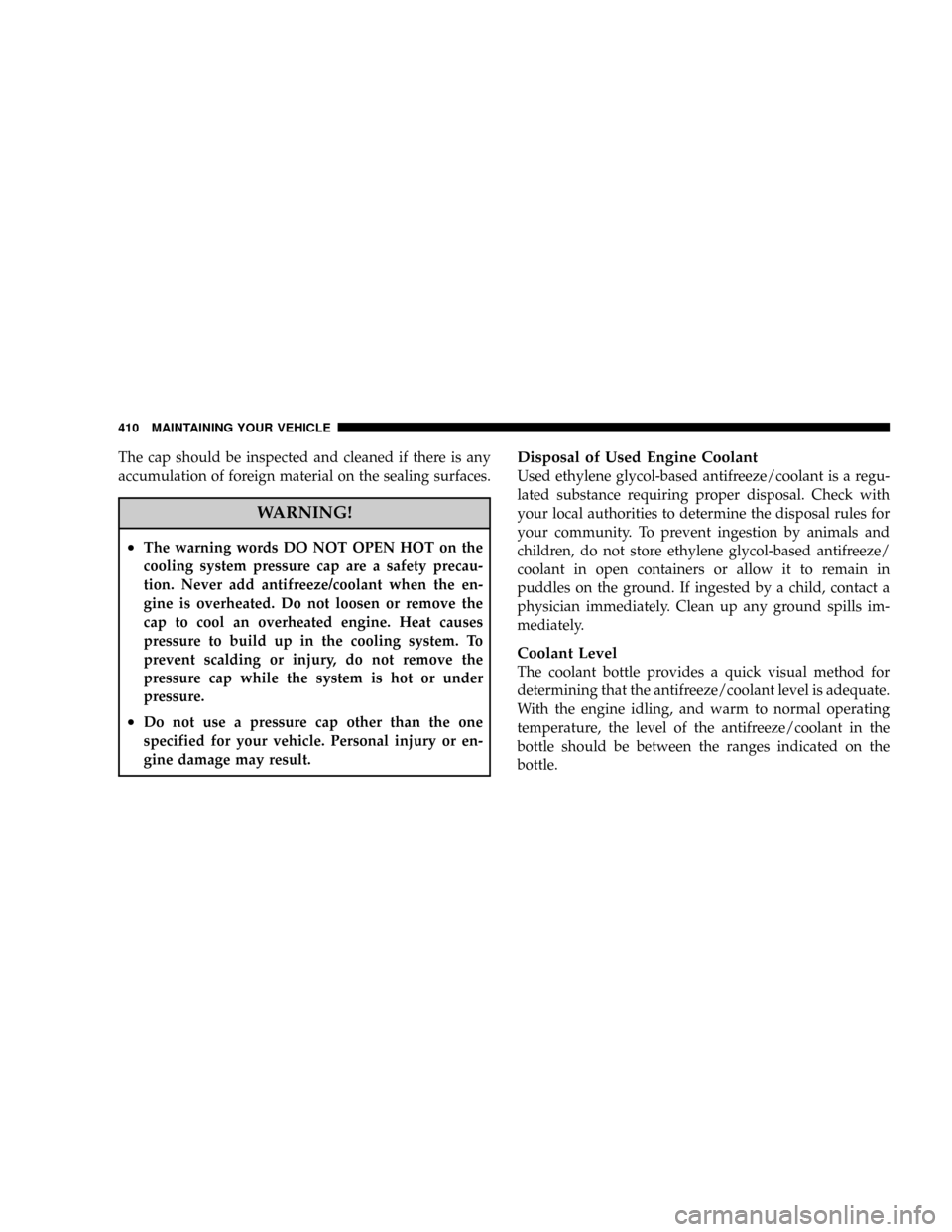
The cap should be inspected and cleaned if there is any
accumulation of foreign material on the sealing surfaces.
WARNING!
²The warning words DO NOT OPEN HOT on the
cooling system pressure cap are a safety precau-
tion. Never add antifreeze/coolant when the en-
gine is overheated. Do not loosen or remove the
cap to cool an overheated engine. Heat causes
pressure to build up in the cooling system. To
prevent scalding or injury, do not remove the
pressure cap while the system is hot or under
pressure.
²Do not use a pressure cap other than the one
specified for your vehicle. Personal injury or en-
gine damage may result.
Disposal of Used Engine Coolant
Used ethylene glycol-based antifreeze/coolant is a regu-
lated substance requiring proper disposal. Check with
your local authorities to determine the disposal rules for
your community. To prevent ingestion by animals and
children, do not store ethylene glycol-based antifreeze/
coolant in open containers or allow it to remain in
puddles on the ground. If ingested by a child, contact a
physician immediately. Clean up any ground spills im-
mediately.
Coolant Level
The coolant bottle provides a quick visual method for
determining that the antifreeze/coolant level is adequate.
With the engine idling, and warm to normal operating
temperature, the level of the antifreeze/coolant in the
bottle should be between the ranges indicated on the
bottle.
410 MAINTAINING YOUR VEHICLE
Page 411 of 490
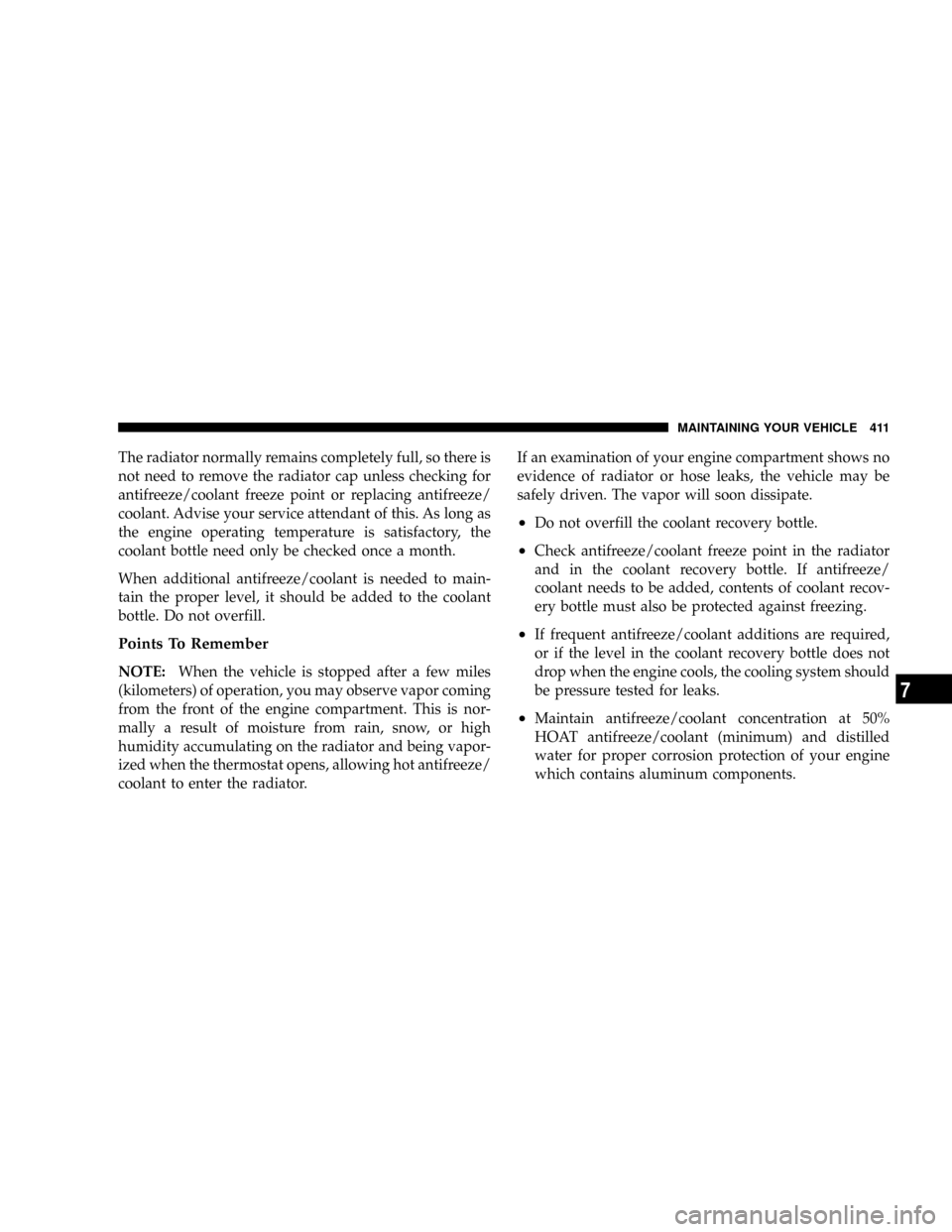
The radiator normally remains completely full, so there is
not need to remove the radiator cap unless checking for
antifreeze/coolant freeze point or replacing antifreeze/
coolant. Advise your service attendant of this. As long as
the engine operating temperature is satisfactory, the
coolant bottle need only be checked once a month.
When additional antifreeze/coolant is needed to main-
tain the proper level, it should be added to the coolant
bottle. Do not overfill.
Points To Remember
NOTE:When the vehicle is stopped after a few miles
(kilometers) of operation, you may observe vapor coming
from the front of the engine compartment. This is nor-
mally a result of moisture from rain, snow, or high
humidity accumulating on the radiator and being vapor-
ized when the thermostat opens, allowing hot antifreeze/
coolant to enter the radiator.If an examination of your engine compartment shows no
evidence of radiator or hose leaks, the vehicle may be
safely driven. The vapor will soon dissipate.
²Do not overfill the coolant recovery bottle.
²Check antifreeze/coolant freeze point in the radiator
and in the coolant recovery bottle. If antifreeze/
coolant needs to be added, contents of coolant recov-
ery bottle must also be protected against freezing.
²If frequent antifreeze/coolant additions are required,
or if the level in the coolant recovery bottle does not
drop when the engine cools, the cooling system should
be pressure tested for leaks.
²Maintain antifreeze/coolant concentration at 50%
HOAT antifreeze/coolant (minimum) and distilled
water for proper corrosion protection of your engine
which contains aluminum components.
MAINTAINING YOUR VEHICLE 411
7
Page 440 of 490
FLUIDS AND CAPACITIES
U.S. Metric
Fuel (Approximate)
3.7/4.7/5.7L Gasoline Engines 21 Gallons 79 Liters
3.0L Diesel Engine 22 Gallons 83 Liters
Engine Oil with Filter
3.7 Liter Engine (SAE 5W-20, API Certified) 5 Qts 4.7 Liters
4.7 Liter Engine (SAE 5W-20, API Certified) 6 Qts 5.7 Liters
5.7 Liter Engine (SAE 5W-20, API Certified) 7 Qts 6.6 Liters
3.0 Liter Diesel Engine (SAE 5W-30 Synthetic, API Certified Low Ash) 10 Qts 9.5 Liters
Cooling System *
3.7 Liter Engine (MopartEngine Coolant/Antifreeze 5 Year/100,000 Mile Formula) 9 Qts 10 Liters
4.7 Liter Engine (MopartEngine Coolant/Antifreeze 5 Year/100,000 Mile Formula) 14.5 Qts 13.7 Liters
5.7 Liter Engine (MopartEngine Coolant/Antifreeze 5 Year/100,000 Mile Formula) 14.5 Qts 13.7 Liters
3.0 Liter Diesel Engine (MopartAntifreeze/Engine Coolant 5 Year/100,000 Mile
Formula)14 Qts 13.2 Liters
* Includes heater and coolant recovery bottle filled to MAX level.
440 MAINTAINING YOUR VEHICLE
Page 441 of 490
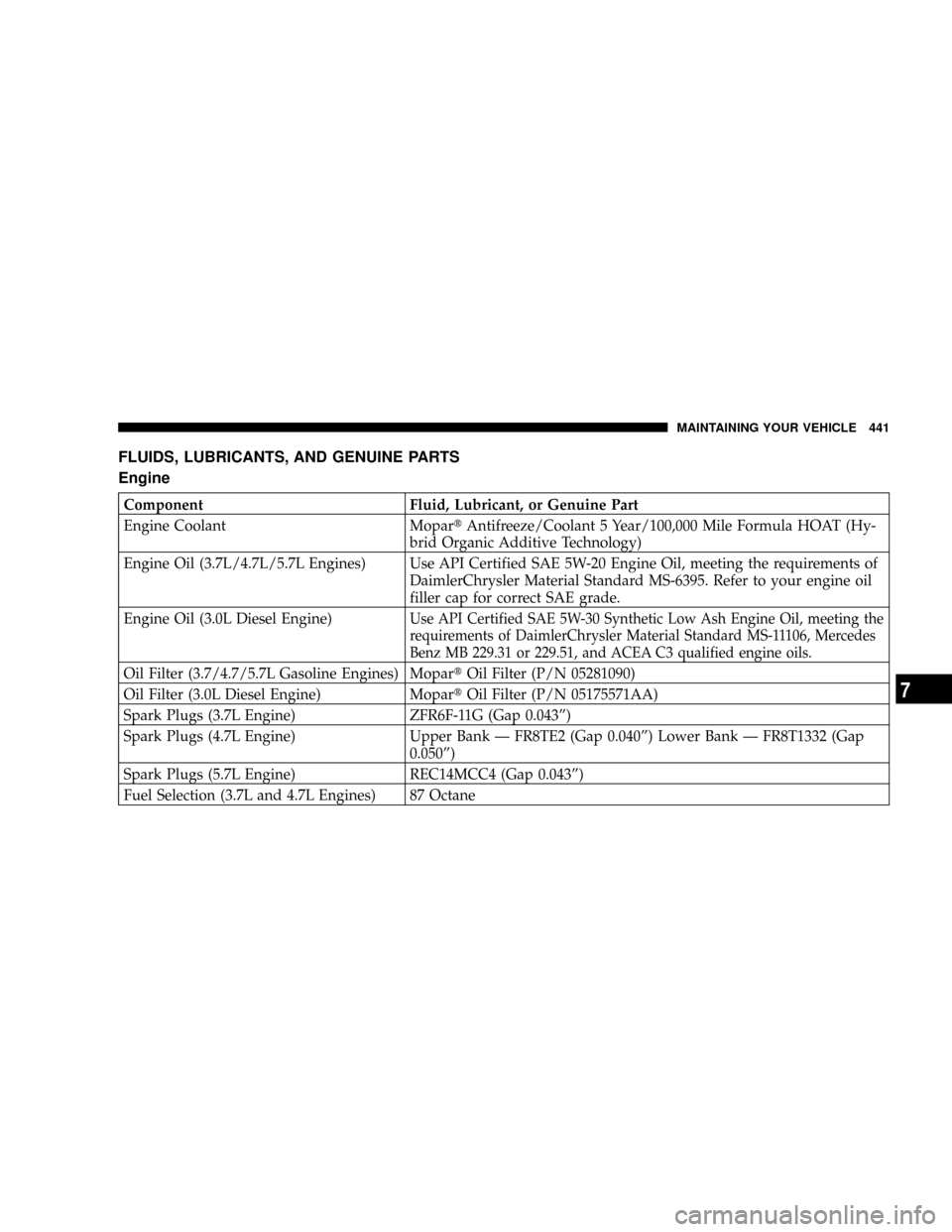
FLUIDS, LUBRICANTS, AND GENUINE PARTS
Engine
Component Fluid, Lubricant, or Genuine Part
Engine Coolant MopartAntifreeze/Coolant 5 Year/100,000 Mile Formula HOAT (Hy-
brid Organic Additive Technology)
Engine Oil (3.7L/4.7L/5.7L Engines) Use API Certified SAE 5W-20 Engine Oil, meeting the requirements of
DaimlerChrysler Material Standard MS-6395. Refer to your engine oil
filler cap for correct SAE grade.
Engine Oil (3.0L Diesel Engine)
Use API Certified SAE 5W-30 Synthetic Low Ash Engine Oil, meeting the
requirements of DaimlerChrysler Material Standard MS-11106, Mercedes
Benz MB 229.31 or 229.51, and ACEA C3 qualified engine oils.
Oil Filter (3.7/4.7/5.7L Gasoline Engines) MopartOil Filter (P/N 05281090)
Oil Filter (3.0L Diesel Engine) MopartOil Filter (P/N 05175571AA)
Spark Plugs (3.7L Engine) ZFR6F-11G (Gap 0.043º)
Spark Plugs (4.7L Engine) Upper Bank Ð FR8TE2 (Gap 0.040º) Lower Bank Ð FR8T1332 (Gap
0.050º)
Spark Plugs (5.7L Engine) REC14MCC4 (Gap 0.043º)
Fuel Selection (3.7L and 4.7L Engines) 87 Octane
MAINTAINING YOUR VEHICLE 441
7
Page 445 of 490

²Change your engine oil more often if you drive your
vehicle off-road for an extended period of time.
²Under no circumstances should oil change intervals
exceed 6,000 miles (10,000 km) or 6 months, whichever
comes first.
Your dealer will reset the oil change indicator message
after completing the scheduled oil change. If this sched-
uled oil change is performed by someone other than your
dealer the message can be reset by referring to the steps
described under ªOil Change Requiredº in ªUse Factory
Settingsº of the EVIC section in this manual.
At Each Stop for Fuel
²Check the engine oil level about 5 minutes after a fully
warmed engine is shut off. Checking the oil level while
the vehicle is on level ground will improve the accu-
racy of the oil level reading. Add oil only when the
level is at or below the ADD or MIN mark.
²Check the windshield washer solvent and add if
required.
Once a Month
²Check tire pressure and look for unusual wear or
damage.
²Inspect the battery and clean and tighten the terminals
as required.
²Check the fluid levels of coolant reservoir, brake
master cylinder, power steering and transmission and
add as needed.
²Check all lights and other electrical items for correct
operation.
MAINTENANCE SCHEDULES 445
8
M
A
I
N
T
E
N
A
N
C
E
S
C
H
E
D
U
L
E
S
Page 448 of 490
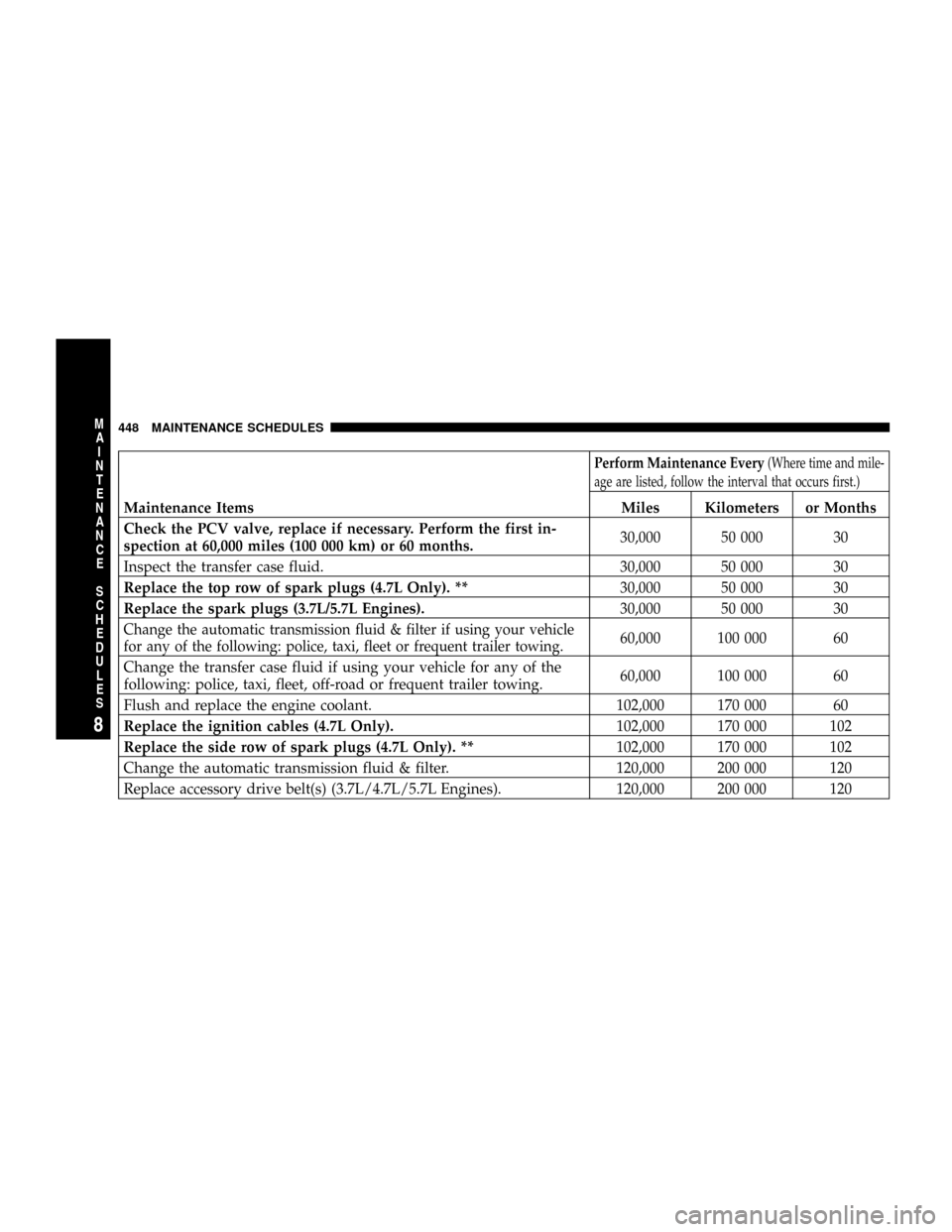
Perform Maintenance Every(Where time and mile-
age are listed, follow the interval that occurs first.)
Maintenance Items Miles Kilometers or Months
Check the PCV valve, replace if necessary. Perform the first in-
spection at 60,000 miles (100 000 km) or 60 months.30,000 50 000 30
Inspect the transfer case fluid. 30,000 50 000 30
Replace the top row of spark plugs (4.7L Only). **30,000 50 000 30
Replace the spark plugs (3.7L/5.7L Engines).30,000 50 000 30
Change the automatic transmission fluid & filter if using your vehicle
for any of the following: police, taxi, fleet or frequent trailer towing.60,000 100 000 60
Change the transfer case fluid if using your vehicle for any of the
following: police, taxi, fleet, off-road or frequent trailer towing.60,000 100 000 60
Flush and replace the engine coolant. 102,000 170 000 60
Replace the ignition cables (4.7L Only).102,000 170 000 102
Replace the side row of spark plugs (4.7L Only). **102,000 170 000 102
Change the automatic transmission fluid & filter. 120,000 200 000 120
Replace accessory drive belt(s) (3.7L/4.7L/5.7L Engines). 120,000 200 000 120
448 MAINTENANCE SCHEDULES
8
M
A
I
N
T
E
N
A
N
C
E
S
C
H
E
D
U
L
E
S